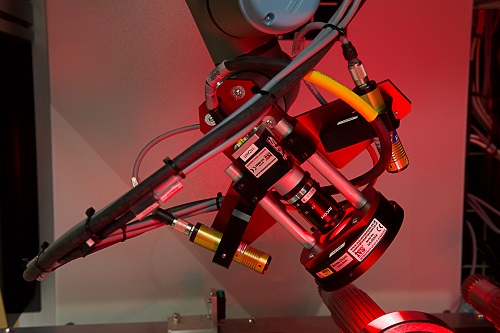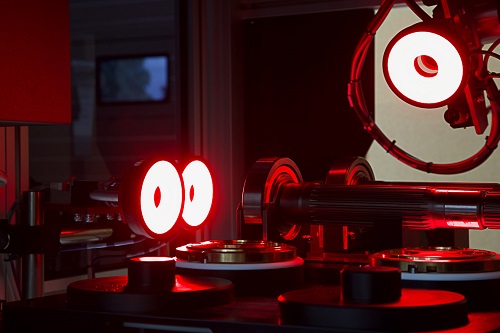Case Studies
Robot inspection systems. IVS combine robots and machine vision.
IVS have combined artificial intelligence machine vision with cutting-edge robot automation to provide a state-of-the-art flexible automated vision inspection cell. High definition camera technology combined with LED lighting and laser projectors allow large products to be inspected at speed with high precision, reducing the need for inspection operators in automated production lines. Such solutions are critical to drive UK productivity within manufacturing and for the drive towards fully flexible manufacturing & Industry 4.0 production control.

Kawasaki Precision Machinery (KPM) approached IVS about developing a fully automated vision inspection system for multiple parts on their dual pump assembly line. In total, six different parts with a total of 63 variants require precision inspection. Historically a human operator would be used for the inspection of such parts, but even utilising 200% manual inspection quality cannot be assured. The parts include stoppers, needle bearings, valve plates, and three different shafts. The inspection criteria includes measuring parts for tolerance checks, verification of the correct types and presence verification of critical build components.
The large number of parts and variants presents a common problem in the world of automated vision inspection as most systems are designed to inspect only a single part with minimal variants. Creating flexibility in system capability generally requires adding equipment and complexity to the system in the form of supplementary sensors, actuators, controllers, and tooling – not to mention the additional programming and system training. All of these further complexities add exponential costs to projects, often making the single “all inclusive” solution more expensive than several “individual part” solutions.
Due to manufacturing floor space constraints, KPM wanted a single, highly flexible vision inspection machine to automatically inspect all six parts and their corresponding variants. KPM also plans to add more parts and variants to the inspection and assembly line in the future. This is also a common issue in industry as automotive designs are frequently changed and improved. If the changes are minimal, the solution is generally straightforward. Slight changes in check routine programming make it possible to inspect the “new” parts. However, inspecting a completely different part (ie. gear vs. shaft) can prove to be extremely difficult and costly, if not impossible. IVS was dedicated to designing and building a single system for KPM that would be capable of inspecting all six parts and 63 variants as well as any future parts and variants that KPM will incorporate.
IVS has engineered vision systems in the past that involve rotary actuators and linear slides to position vision systems for inspection at different points on a part. However this still requires several cameras and actuators to inspect a single part, often allowing for no additional part variant changes in the future. Therefore providing the “eyes” for a robot to inspect the part is the latest innovation from IVS. Our machine vision solutions utilise artificial intelligence machine vision algorithms to allow the robot vision to “learn” the difference between good and bad parts. As the vision sees more samples the variations in products are learnt by the system and the system improves, when enough samples have been seen the system runs autonomously making decisions on part acceptance or failure for quality.

It was clear to the IVS team that using a collaborative robot (cobot) was the perfect solution. By integrating a six-axis robot into the vision inspection system, IVS was able to eliminate the need for multiple cameras and the actuators that move these cameras around. The robot can position the camera head at almost any angle in almost any position, allowing complete three dimensional checks of parts. The camera system is further combined with both laser projection and standard LED lighting technology allowing multiple analysis of both standard images and laser edge detection. Using the robot allows a single vision machine to inspect endless parts and variants. This makes the inspection system future proof as KPM can add new parts and variants to the system capabilities at their leisure.
IVS designed a complete machine that fits in the production line upstream of a part pressing process. An operator loads the parts to be inspected on a pallet and the pallet is driven to the input side of the machine’s conveyor. When prompted, the machine moves the pallet into the inspection cell surrounded by tinted in-fill panels for operator safety. The robot positions the camera in several places for the vision system to determine what part is present and what inspection sequence to run. Once the specific part and variation is determined, the inspection machine performs all the checks for that particular component based on its prescribed check routine. Once complete, the factory information system is notified of the pass/fail outcome of the part and the reason for any failures. The pallet is then moved out of the inspection cell automatically on the outfeed of the conveyor. IVS has supplied operator and engineer training to KPM to allow KPM employees to program and test new parts and variants in the inspection system.

IVS has successfully supplied KPM with a vision inspection machine that meets all their needs and more. The vision inspection machine fits within the new production line and feeds directly to the downstream processes, eliminating the need to reconfigure the manufacturing line setup. By reducing operator intervention for the inspection process IVS help KPM guarantee 100% defect free product to their customer.
The flexible vision cell is future proof, KPM can program the machine and robot to inspect countless parts and part variants. IVS developed the check routines to be independent of the factory communication system or operator input, allowing the machine to determine what part is presented before performing the checks. This removes the potential for operator or communication system error of misinforming the machine of what part has been loaded for inspection. Operator safety took a key role in the design and build of the machine. Emergency Stop buttons are located in multiple points on the machine, and the inspection cell is completely enclosed by tinted in-fills to protect both operator limbs and eyes. In addition the robot is human collaborative, meaning it is safe for humans to interact with and will stop its movements if it feels and external force acting upon it. Not only does the vision machine automate the inspection process, removing the human error element, but it also decreases inspection time, decreasing overall production time, whilst at the same time guaranteeing quality. An operator would never be able to cope with the inspection of the large number of variants at a consistent level.
By designing a single machine for all the parts and variants, IVS eliminated the need for four separate machines to cover the six different parts. IVS has developed a first-of-its-kind automated inspection cell that exceeds customer expectations, performs flawlessly, and fits well within the project budget and timeframe. This is a real innovation which builds the foundations for the removal of operators with robot and vision technology signalling a move to the “lights out” factory of tomorrow, allowing UK industry to capitalise on the very latest developments in vision and robotic control for quality control.
